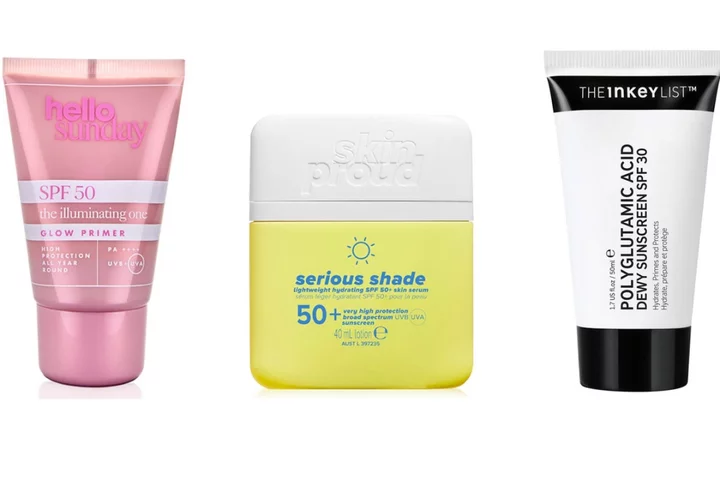
3 New York Mets to blame for disappointing start to season
The New York Mets have started the 2023 season nowhere close to where they thought they'd be but these three players deserve a ton of blame for that.When the New York Mets saw that May began with series against the Tigers, Rockies and Reds, they had to be licking their chops. After all, wit...
1970-01-01 08:00

3 key reasons to the Sixers Game 5 win over Celtics
The Philadelphia 76ers are one game away from the Eastern Conference Finals after winning Game 5 against the Celtics. Here's why the Sixers got the victory.The Philadelphia 76ers beat the Boston Celtics, 115-103, in Game 5 on Tuesday night. As the series now heads back to Philadelphia, they...
1970-01-01 08:00

3 times Aaron Boone could've been fired this season and 1 reason he shouldn’t be
New York Yankees manager Aaron Boone is in hot water in the 2023 season.Recently, Yankee fans have been hard on manager Aaron Boone. Are the boos and the "fire Boone" chants warranted?It isn’t surprising that fans are frustrated with the Yankees being in last place in the Ame...
1970-01-01 08:00

SEC Football: 5 incredibly early bold predictions for the 2023 season
It's early and I'm bored, so here are five way-too-early predictions for the upcoming SEC football season, aight.I've been to the future and seen what's up. And now, I'm not going to help you navigate the stock market, bro...About four months from now, the only colle...
1970-01-01 08:00

3 key players who helped the 76ers win Game 4 over the Celtics
The 76ers were able to win Game 4 against the Celtics. This game went to overtime and the 76ers needed a masterclass of a performance from James Harden.The Philadelphia 76ers won Game 4 against the Boston Celtics, 116-115. This was one of the best playoffs game of the season, especially after th...
1970-01-01 08:00

9 actually useful things you can do to support teens this exam season
Exam season is underway, and many teenagers might be feeling overwhelmed about the important tests they’re facing over the next few months. “Sitting exams is often one of the most overwhelming and high pressure experiences teens face, and students often put immense pressure on themselves,” says Lara McIvor, a revision expert at Save My Exams. “For parents with children taking exams, it can be difficult to know how best to support their child without being too involved or under-supportive. “As parents and teachers, it should be our mission to ensure students have access to clear support systems, coping mechanisms and study techniques over these challenging few months, and we should all be better educated in the warning signs of stress in teens.” And Matt Buttery, CEO of the Triple P Positive Parenting Programme, adds: “This can be a stressful time, but the good news is that parents can support young people and help remove some of the pressure around exam season. By setting a positive example and encouraging them, you can help ensure they remain happy and healthy, as well as reach their full academic potential.” So what can parents and carers do to actually make the whole exam experience better for teens? 1. Encourage them to chat with you Encourage open communication, and if your teen seems stressed, ask if they’d like to talk through revision together, or more broadly discuss their concerns, suggests Buttery. “It’s important your child knows you’re there for them if they need you,” he stresses. 2. Set up a quiet study area Ensuring your child has an optimum place to study without distractions is vital to their success, McIvor says. “Often concentration can wane, so making sure there are limited external distractions – such as loud music or TV – will allow for the best results and prepare them for their silent exams,” she says. 3. Don’t just rush to make them feel better It’s vital to acknowledge what teenagers are feeling, rather than just trying to make it go away, stresses psychologist Dr Audrey Tang. “One of the most important things anyone can do is validate their right to feel as they do,” she explains. “We’re not very good at sitting with anxiety and often rush to try and make it go away or to feel better, and this can lead us to quick fixes which can include unhealthy behaviour choices such as not bothering to try, often led by unhealthy thoughts like ‘If I don’t try, I can’t fail’.” 4. Help teenagers unpack their feelings Encourage teens to analyse or unpack how they’re feeling about their exams and revision, advises Tang. “If we take a moment to respect our feelings, and try to unpack exactly what we’re worrying about, we may be able to work out what we need to do next,” she explains. For example, is your teen’s anxiety caused by them not understanding some things, and if it is, which specific bits are causing the problem? Or is it linked to knowing their parents are stressed and not wanting to add to it, and if that’s the case, are other services available? “When we begin to unpack our feelings, rather than suppress or deny them, we have a better idea of what action is going to help us the most,” Tang explains. 5. Help with visual prompts Creating an ongoing learning environment throughout the exam period is key, says McIvor. She suggests sticking notes with key quotes, equations, etc on them around the house in places where your child can always see them. “This can be really useful for some students as it allows for constant exposure to materials,” she explains. 6. Avoid ‘toxic positivity’ If a teenager says things like, ‘I’m so stupid’, or ‘I’m rubbish at everything’, it’s natural for parents to tell them they’re brilliant, observes Tang. “Unfortunately, this has the effect of not validating those emotions, and the opportunity to understand what they’re trying to say is lost,” she explains. “A better way to navigate that discussion would be to acknowledge the feeling with something like ‘I’m really sorry you’re feeling that way’, and asking for more information.” 7. Be a good role model Role modelling healthy ways to manage your own anxiety is hugely important, stresses Tang. “Why would you expect a young adult to listen to you if you aren’t showing in your own practice that what you’re suggesting works?” she asks. And Buttery advises parents to lead by example by staying positive and calm when talking about exams. “Avoid using phrases such as, ‘You must be nervous’,” he says, “As you may risk accidentally making an otherwise calm child more stressed. Children learn a great deal about how to manage their behaviour and deal with difficult situations from their parents. By demonstrating calm and resilient behaviour, parents can have a positive influence on their children’s ability to cope with adversity.” 8. Try stressbusting techniques together Tang suggests practising self-care or stressbusting techniques together, such as affirmations with deep breathing. One technique, she says, is to get your child to note down everything they need to do and its relative importance on a pie chart, where the size of the slice shows the importance of the activity. Then ask them to draw on a scale of zero in the centre, to 10 on the outside, where they are in each segment. “This gives them a visual representation of what they need to do, and where they are, as well as an indication of the areas they’re neglecting, and how important those areas are,” she says. “By having everything on one pie chart, it might feel a lot more manageable.” 9. Maintain the family routine Ensuring family dinners and other rituals remain part of daily life can help teenagers cope with exam stress, as routine is predictable and reassuring at a time of pressure and uncertainty. Maintaining structure can also help your child plan their downtime, stresses Buttery, who adds: “It’s important to ensure they’re taking time to relax and unwind, whether by watching their favourite TV show, playing a game, or hanging out with friends.” Read More Charity boss speaks out over ‘traumatic’ encounter with royal aide Ukraine war’s heaviest fight rages in east - follow live Children In Need removes Pudsey’s bandana to show not all challenges are visible Is your child too anxious to go to school? What’s the link between the menopause and anxiety?
1970-01-01 08:00

Liz Weston: 3 steps to downsize in a hurry
Despite our plans, life sometimes throws a curveball
1970-01-01 08:00

'Succession': 13 WTF quotes that will haunt my nightmares from episode 8
Another week, another Succession episode packed full of WTF moments. Episode 8 of the final
1970-01-01 08:00

Mother's Day: 5 ways to surprise your mom and make her day
Mother's Day is a day to celebrate mothers, motherhood, and maternal bonds, and we bring to you 5 ways you can show love and appreciation to your mom
1970-01-01 08:00

11 lightweight SPFs your skin will love
‘Use sunscreen every day’ is the ultimate skincare commandment. Dermatologists and beauty buffs alike agree that protecting your face from harmful UV rays – while simultaneously preventing wrinkles – should be a priority for everyone. “Skin is the body’s first line of defence from everyday external aggressors which damage your skin such as UV rays,” says Prof Christian Aldridge, consultant dermatologist for LifeJacket Skin Protection. “The damage from these can have cosmetic, physical and long-term health consequences. At best, it can age your skin and cause you discomfort but at worst, can give you a skin disease you really don’t want.” That’s why daily protection of your skin is critical, particularly on those areas that are exposed to the sun regularly, such as your face. But in spite of all the warnings we receive, the message isn’t getting through to everyone. A new survey from LifeJacket and Melanoma UK found that 10% of respondents rarely use SPF, while one in 20 says they never use it. To make it more likely you’ll stick to a daily habit, finding a product you love can be a huge help – attempting to rub a thick, chalky cream into your skin is not the answer. The good news is, facial sunblocks have come a long way, and there’s a whole new batch of lightweight but effective lotions, serums and gels that are a delight to use – and many of them are under the £20 mark. “To adequately protect your face, I recommend 5ml (about a teaspoon) of SPF of at least 30 every day,” says Aldridge. “Especially during the months of April to September, to ensure long-term skin protection. Application should be repeated if outside for long periods or undertaking exercising in the light.” Here’s our pick of the best face sunscreens for everyday use… 1. Garnier Ambre Solaire SPF 50+ Super UV Invisible Face Serum, £14, Boots A more fluid texture than any existing Garnier sunblock, Super UV Invisible Face Serum is designed for even the most sensitive skin types. The vegan factor 50 serum sinks in quickly, meaning it’s suited to men with facial hair or for wearing under make-up. 2. Sun Bum Glow 30 Moisturising Sunscreen Face Lotion, £19.99, Cult Beauty The latest addition to the Sun Bum family, this SPF30 lotion comes with a generous dose of glow-boosting kakadu plum extract, which reportedly contains on average 100 times more vitamin C than an orange. 3. The Inkey List Polyglutamic Acid Dewy Sunscreen, £14.99, LookFantastic Fast becoming a must-have among ‘skintellectuals’, this light fluid is formulated with a trio of ultra-hydrating ingredients: polyglutamic acid, squalane and glycerin. Designed to prevent any white cast (no matter how dark your skin tone), this dewy-finish fluid is what you need if you’re after the trendy ‘glazed donut’ skin look. 4. Coco & Eve Daily Water Gel SPF50+ Sunscreen, £23 The first suncare range from self-tan specialist Coco & Eve does not disappoint. With hyaluronic acid to moisturise, the factor 50+ Daily Water Gel is as lightweight as it sounds, and the fragrance-free formula is suited to sensitive and oily skin types alike. 5. Skin Proud Serious Shade Lightweight Hydrating SPF 50+ Skin Serum, £16.95 Intended to provide a smooth base for make-up with no white cast, Skin Proud’s first sunscreen comes with extra benefits: ceramides to protect the skin barrier and cherry extract for a vitamin C boost. 6. Eucerin Sun Face Hydro Protect Ultra-Light Fluid SPF 50+, £20, Boots The newest face sunblock in Eucerin’s high-tech line-up not only protects against UVA and UVB rays, it boosts skin repair with glycyrrhetinic acid, and the non-greasy fluid is fast-absorbing. 7. Ole Henriksen Banana Bright Vitamin C Mineral SPF30, £28 If you prefer a mineral suncreen that provides a physical barrier on the skin (as opposed to chemical, where it works below the surface), Ole Henriksen’s Banana Bright is an excellent option. The zinc oxide-based formula also contains vitamin C to increase skin luminosity over time and banana powder-inspired pigments to add instant brightness. 8. Suqqu Protecting Day Cream SPF50+, £48, Cult Beauty This innovative daily moisturiser from Japanese skinbrand Suqqu offers factor 50 protection, botanical extracts and a glowy, light-reflecting finish that’s perfect on its own or under make-up. 9. Chanel UV Essentiel, £48 The newly reformulated UV Essentiel provides SPF50 protection alongside a duo of skin-strengthening extracts – blue ginger and Tahitian gardenia – to guard against pollution and premature ageing. 10. LifeJacket Daily Protection Moisturiser, £19.99 A great all-rounder, LifeJacket’s fragrance-free face cream provides factor 30 protection and hydrates with glycerin. 11. Hello Sunday The Illuminating One Glow Primer SPF50, £22 Defending skin against UVA, UVB, blue light and pollution, this highly protective primer is formulated with light-illuminating particles to enhance your complexion.
1970-01-01 08:00

4 signs you’ve eaten too much salt
Feeling the urge to glug a glass of water shortly after you’ve munched a packet of crisps, bowl of popcorn or handful of peanuts, is a clear sign your snack was on salty side – and that’s not necessarily a bad thing. “Salt is a necessary requirement to eat – and not for flavour,” says Pippa Hill, nutritionist and founder of The Weight Loss Guru. Table salt, aka sodium chloride, contains around 40% sodium, an essential nutrient. “Eaten in a small quantity, sodium helps the conduction of nerve impulses, muscle contraction and relaxation, and helps maintain the balance of water and minerals,” she continues. “A lack of salt can lead to muscle cramps, nausea, fatigue and light-headedness.” However, consuming more than the 6g a day recommended by the NHS for adults – equating to around one teaspoon – can be detrimental for your health. “A high salt intake disrupts the natural sodium balance in the body,” says Olivia Burley, registered associate nutritionist who is currently working on the NHS Diabetes Prevention Programme. This can result in high blood pressure, she explains: “Hypertension is a condition where blood pressure remains elevated over time, which can increase the risk of heart and circulatory diseases.” Unless you keep a very close eye on food labels, it’s not always obvious how much salt you’re eating in a day. “Examples of foods high in salt can be canned fish or poultry, frozen foods such as breaded meats, salted nuts, canned beans, cured meats, soup and sandwiches,” says Hill. And just because you’ve drunk enough water to quench your thirst doesn’t mean you’re negating the effects of too much salt, which is why it’s important to be aware of other health indicators. “If you are experiencing any or all these symptoms, it is always best to seek medical advice,” Burley advises. 1. Headaches The dehydration caused by excess salt intake can lead to severe headaches. “These headaches tend to be more painful than a mild one, giving a throbbing sensation as the blood vessels are being expanded,” Hill says. “They tend to come on between an hour or two after you’ve eaten, as sodium levels rise through the body.” They may come on quicker if you have high blood pressure or suffer from chronic headaches in general, but can often be solved by rehydrating. “As your water levels are imbalanced, by drinking more water you’re able to minimise and get rid of the headache.” 2. Swollen feet and hands Also known as edema, swelling of the fingers, ankles or feet can be a delayed reaction to a spike of sodium. “When too much salt is consumed, the body retains the extra sodium and increases the fluid outside of the cells, Burley explains. “This causes the kidneys to have reduced function, remove less water and therefore increase blood pressure.” Swelling may occur more when sitting down for too long or on long journeys. “This isn’t an instant response after eating, but if in the next 24 hours of having eaten salty foods you notice swelling in these areas, it could be a link,” Hill says. “It’s best to seek medical advice if this is an ongoing occurrence, as it could be a sign of a more serious health concern.” 3. High blood pressure “Salt is the largest cause of high blood pressure,” Hill warns. “Within just 30 minutes, eating excess salt will have a bodily reaction to the blood vessels.” Also called hypertension, if left untreated it can increase your risk of serious problems such as heart attacks and strokes. Hills says: “If after eating a salty diet, your symptoms include blurred vision, chest pain such as a tight feeling, palpitations, shortness of breath or sudden nosebleeds, it could mean you have a raised blood pressure.” Burley adds: “Hypertension can often have no symptoms and the only way to know your blood pressure is to get it monitored using a machine.” 4. Frequent urination “Excessive thirst is a common response to eating salty foods and naturally leads to an increase in fluid consumption, causing excessive urination,” Burley says. By sending the signal that you need to guzzle lots of liquid, the body aims to remove the excess salt build-up. “Although drinking more fluids in response to an increase in salt is one of the main reasons for urine production, it could be a symptom of other conditions like polyuria, therefore medical checks are best.” Read More Charity boss speaks out over ‘traumatic’ encounter with royal aide Ukraine war’s heaviest fight rages in east - follow live Am I just tired or is it ME? Dr Alex George: Five months of sobriety has made a ‘huge difference’ Everything you need to know about Sophie, the new Duchess of Edinburgh
1970-01-01 08:00

10 clever ways to style up your home office
Working from home has become our natural habitat, so it’s even more important your day-to-day desk space serves its purpose. With warmer weather on the horizon, it could be time to give your home office a refresh for brighter days ahead. Here’s how to get a little more organised and up your WFH game… 1. Sarah JK Designs Book Journal, Summer Blooms, £14.95 Whether it’s meeting bullet points or words of wisdom, this A5 softback journal is perfect for jotting down notes and thoughts of the day. 2. Furniture Village Madrid Desk, £399 (was £539), Holden Swivel Office Chair in Brown, £169 (was £229) This Scandi-style desk with tapered legs will slot into any scheme, and features a central drawer to keep techy stuff out of sight when the day is done. Team with a smart swivel chair for maximum comfort. 3. Zuiver Cute Desk Collection Clock in Green, £19 (was £29), Cuckooland A trendy sage green clock will slick up your desk accessories – style it with mood-boosting succulents and plants. 4. Set of Three Odonata Box Files – Red Madder, £65, OKA When you want to be clever, these brilliant binders will fuel your filing power. 5. William Blake Framed Wall Art, £59.50, (A3), top right, Oliver Bonas A feature wall of framed art makes a statement and can channel your creative best. Think William Blake’s poem ‘The Tyger’ in a wooden frame. 6. Cambridge Print Small Letter Trays: Selvedge Madder, £25, top; Charleston Meander, £25, bottom, Cambridge Imprint Time to push the envelope – these jazzy letter trays are where it’s at. 7. Evelyn Oak Effect Folding Desk, £49, Stanis Dining Chair, Velvet in Black, £89, Smart Industrial Calendar Block, £20, Dunelm When you want the option to power up or close down, this fashionable folding desk can be stored away when not in use – and the velvet chair can serve as an extra dining seat. 8. Shards Design – Large Magnetic Notice Board in Ocean, £58, Beyond The Fridge Designed to inspire and organise your world, this magnetic mood board can be styled to suit your surroundings. 9. Furniture Choice Milton Oak 120cm Dining Table in Oak, £179.99 This solid table is designed for modern living and will fit into any officescape with its classic design. 10. Martha Brook Desk Accessories: Pastel Scalloped Pen Pot, Light Lilac, £20.95, Two Tone Pastel Pen Pot, £20.95, Pastel Grooved Coaster Or Pen Holder, £19.95 Funky and fun, these pastel pen pots and holders will make light of a heavy workload. Read More Charity boss speaks out over ‘traumatic’ encounter with royal aide Ukraine war’s heaviest fight rages in east - follow live 5 sunglasses trends that will be everywhere this summer 11 of the most eye-popping outfits in Eurovision history, from ABBA to Australia Can I go to work if my child has chickenpox?
1970-01-01 08:00
